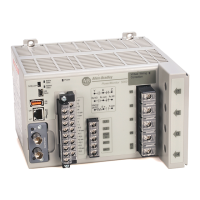84 Rockwell Automation Publication 1426-UM001J-EN-P - August 2019
Chapter 4 Metering
If your electric utility provides a pulse that indicates the end of each demand
interval, the power monitor can be configured to determine its demand interval
from the utility pulse.
Some electric service providers use the sliding window method. This method
breaks the demand interval into many subintervals and updates the demand value
at the end of each subinterval.
For example, a 15 minute interval can be divided into 15 one-minute
subintervals. Each minute, the following occurs:
• The demand for the subinterval is calculated and stored.
• The average value of the most recent 15 subintervals is computed to obtain
a demand value.
• Subinterval values older than 15 minutes are discarded.
Projected Demand Calculation
Projected demand calculates an instantaneous (default) or first-order projection
of demand at the end of a demand interval. Select the best projection method for
your system by comparing the projected values from each method with the actual
demand at the end of the interval. The following sections describe the methods of
projecting demand.
Instantaneous
The power monitor computes instantaneous demand by substituting the elapsed
interval duration for the total interval duration (T) in the demand equation. The
power monitor computation is therefore identical to the standard computation.
The one exception is that the power monitor integrates the power only over the
elapsed interval duration and calculates the average value over the elapsed
duration. The modified equation thus becomes:
(t2 - t1) = Elapsed interval duration and is less than T
First Order Projection
The first order demand projection does the following:
• Uses the instantaneous demand as a starting point
• Computes the trend of the instantaneous demand
• Computes the time remaining in the interval
• Performs a first order projection of what the final demand is at the end of
the interval
This method can be useful where your system has a significant base load with
additional loads that are switched in and out during the interval.

